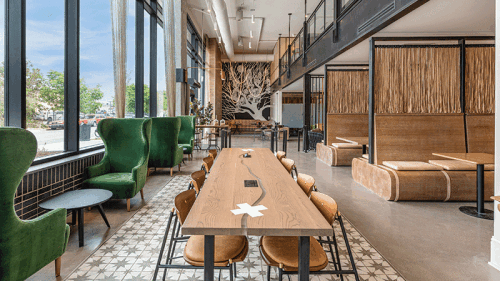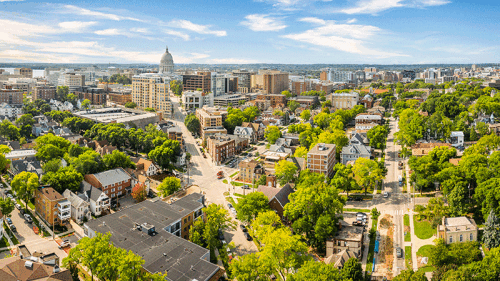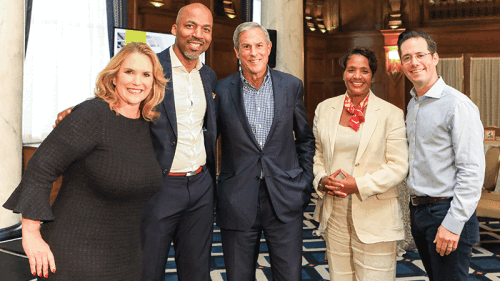The middle tier of U.S. cities—places like Kansas City, Missouri; Charleston, South Carolina; and Knoxville, Tennessee—may have lower populations, fewer cultural offerings, and less cosmopolitan flair than New York City, Chicago, San Francisco, and the like, but they also have their own advantages over the behemoths, according to a ULI panel of mayors. “We’re making our mark by being authentic and building on the strengths we have,” said Knoxville Mayor Madeline Rogero.
Rogero was part of a mayors’ roundtable discussion at the ULI J.C. Nichols Forum, held in Nichols’s hometown of Kansas City on September 29 to highlight emerging trends in middle-tier cities. She was joined on the panel by Kansas City Mayor Sly James; Joe Reardon, former mayor/chief executive officer of the Unified Government of Wyandotte County/Kansas City, Kansas, and current president of the Greater Kansas City Chamber of Commerce; and former Charleston, South Carolina, Mayor Joseph Riley Jr., a ULI J.C. Nichols Prize for Visionaries in Urban Development laureate. Their discussion was moderated by Paul Goldberger, a contributing editor at Vanity Fair and an architecture critic who won the 1984 Pulitzer Prize for Distinguished Criticism.
The theme of ULI’s first-ever Nichols Forum was the emergence of “18-hour” cities for real estate development. ULI coined the term “18-hour cities” as an alternative to “second tier” because the downtowns in such cities were no longer 9-to-5 centers but not quite on par with the always-active “24/7” cities, said Patrick L. Phillips ULI global chief executive officer. ULI’s Emerging Trends in Real Estate® 2016 report found that 18-hour cities such as Austin, Texas; Charlotte, North Carolina; and Nashville, Tennessee, occupied most of the top ten rankings for the most favorable U.S. markets for commercial and residential investment, according to a survey of real estate executives. As Riley observed, “We are in a time of the great emergence of cities.”
The mayors’ panel discussed several advantages that 18-hour cities have over the nation’s largest cities: a lower cost of living, less congestion, and more affordable housing costs. But each mayor also outlined how his or her city progressed by focusing on organic improvements and staying true to the city’s “DNA,” or unique character.
In the case of Knoxville, Rogero said the city earlier this century resisted erecting a dome over downtown’s Market Square and instead pursued a series of nature preservation projects, including miles of trails, as a way to build on its proximity to the Great Smoky Mountains.
“It was building on our beauty and natural assets, and it’s one of the things attracting young people to our city, rather than a ‘silver bullet’ project,” Rogero said.
As mayor for more than 40 years, Riley oversaw the transformation of Charleston’s dilapidated waterfront and the revitalization of a half-decrepit historic merchant district with an explosion of restaurants. But he balked at one point when a developer wanted to add a Hard Rock Café. “It didn’t fit our DNA,” Riley said.
Then earlier this decade, when Charleston’s Upper King Street bar district grew a little too big and noisy, Riley pushed for a limitation on the number of bars on a single block, among other solutions. It was a matter of protecting neighborhood scale. “What we have is the opportunity and responsibility to keep working on scale, and especially neighborhood scale, . . . so each citizen feels a real sense of place,” he said.
City leaders for Kansas City, Missouri, and its neighbor Kansas City, Kansas, cited an advantage of being small and nimble enough to carry out collaborative, citywide public/private initiatives. One example was Google’s choice of the two cities as the first in the country for the deployment of high-speed Google Fiber broadband-to-the-home service. Google representatives—including Rachel Hack Merlo, Google community impact manager in Kansas City, during the Nichols Forum—cited the cities’ entrepreneurial roots and willingness to streamline the development permitting process, something an 18-hour city is better able to accomplish than a larger, more bureaucratic city.
Google Fiber began operating in the Kansas City area in 2012 and is hailed for attracting a slew of technology startup entrepreneurs who have renovated urban dwellings and revitalized neighborhoods to take advantage of high-speed web surfing. “You cannot underestimate the impact of that,” said James. “It was one of those things we were able to leverage” to attract millennials.
Despite these differences from larger U.S. metro areas, 18-hour cities do face some of the same challenges as their larger brethren. According to the ULI mayors panel, these challenges include racial strife, poor schools, urban blight, unfunded federal mandates, and state legislative meddling in local issues. Yet, these mayors believe 18-hour cities are in a better position today to compete nationally for new residents and businesses.
James explained how he talks to millennials who have relocated from places like Los Angeles, saying he asks why they moved to Kansas City. They mention things like quality of life, housing affordability, the city’s natural beauty, its vibrant arts scene, even Google Fiber, among other things. “They say, ‘You have the things we wanted,’” James said.
Jeffrey Spivak, a market research director in suburban Kansas City, Missouri, is an award-winning writer specializing in real estate development, infrastructure, and demographic trends.




